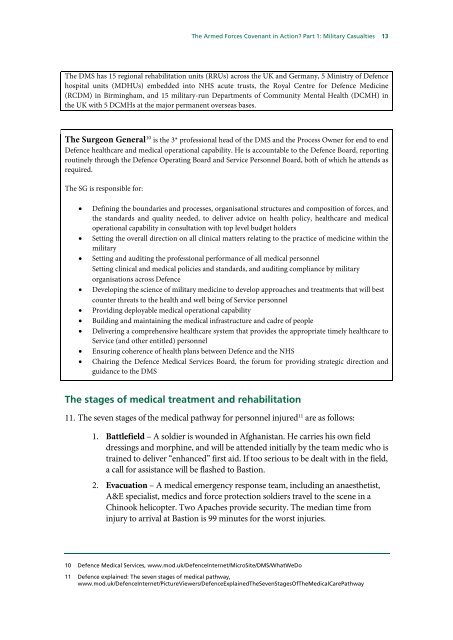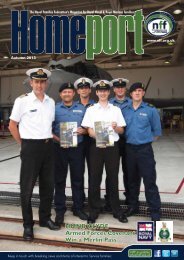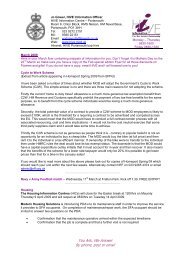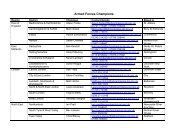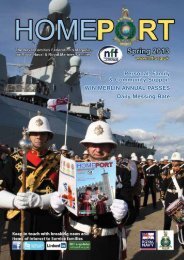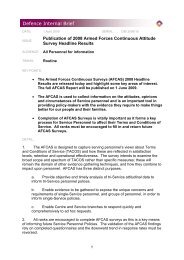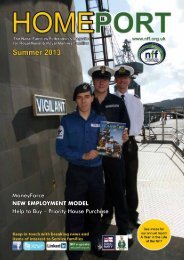to read the full report - NFF
to read the full report - NFF
to read the full report - NFF
- No tags were found...
Create successful ePaper yourself
Turn your PDF publications into a flip-book with our unique Google optimized e-Paper software.
The Armed Forces Covenant in Action? Part 1: Military Casualties 13The DMS has 15 regional rehabilitation units (RRUs) across <strong>the</strong> UK and Germany, 5 Ministry of Defencehospital units (MDHUs) embedded in<strong>to</strong> NHS acute trusts, <strong>the</strong> Royal Centre for Defence Medicine(RCDM) in Birmingham, and 15 military-run Departments of Community Mental Health (DCMH) in<strong>the</strong> UK with 5 DCMHs at <strong>the</strong> major permanent overseas bases.The Surgeon General 10 is <strong>the</strong> 3* professional head of <strong>the</strong> DMS and <strong>the</strong> Process Owner for end <strong>to</strong> endDefence healthcare and medical operational capability. He is accountable <strong>to</strong> <strong>the</strong> Defence Board, <strong>report</strong>ingroutinely through <strong>the</strong> Defence Operating Board and Service Personnel Board, both of which he attends asrequired.The SG is responsible for:• Defining <strong>the</strong> boundaries and processes, organisational structures and composition of forces, and<strong>the</strong> standards and quality needed, <strong>to</strong> deliver advice on health policy, healthcare and medicaloperational capability in consultation with <strong>to</strong>p level budget holders• Setting <strong>the</strong> overall direction on all clinical matters relating <strong>to</strong> <strong>the</strong> practice of medicine within <strong>the</strong>military• Setting and auditing <strong>the</strong> professional performance of all medical personnelSetting clinical and medical policies and standards, and auditing compliance by militaryorganisations across Defence• Developing <strong>the</strong> science of military medicine <strong>to</strong> develop approaches and treatments that will bestcounter threats <strong>to</strong> <strong>the</strong> health and well being of Service personnel• Providing deployable medical operational capability• Building and maintaining <strong>the</strong> medical infrastructure and cadre of people• Delivering a comprehensive healthcare system that provides <strong>the</strong> appropriate timely healthcare <strong>to</strong>Service (and o<strong>the</strong>r entitled) personnel• Ensuring coherence of health plans between Defence and <strong>the</strong> NHS• Chairing <strong>the</strong> Defence Medical Services Board, <strong>the</strong> forum for providing strategic direction andguidance <strong>to</strong> <strong>the</strong> DMSThe stages of medical treatment and rehabilitation11. The seven stages of <strong>the</strong> medical pathway for personnel injured 11 are as follows:1. Battlefield – A soldier is wounded in Afghanistan. He carries his own fielddressings and morphine, and will be attended initially by <strong>the</strong> team medic who istrained <strong>to</strong> deliver “enhanced” first aid. If <strong>to</strong>o serious <strong>to</strong> be dealt with in <strong>the</strong> field,a call for assistance will be flashed <strong>to</strong> Bastion.2. Evacuation – A medical emergency response team, including an anaes<strong>the</strong>tist,A&E specialist, medics and force protection soldiers travel <strong>to</strong> <strong>the</strong> scene in aChinook helicopter. Two Apaches provide security. The median time frominjury <strong>to</strong> arrival at Bastion is 99 minutes for <strong>the</strong> worst injuries.10 Defence Medical Services, www.mod.uk/DefenceInternet/MicroSite/DMS/WhatWeDo11 Defence explained: The seven stages of medical pathway,www.mod.uk/DefenceInternet/PictureViewers/DefenceExplainedTheSevenStagesOfTheMedicalCarePathway


